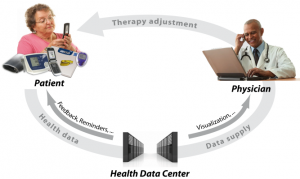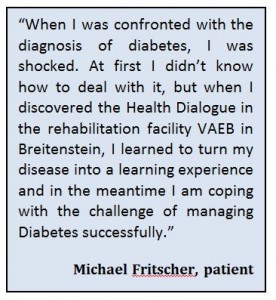The Gesundheitsdialog: Advanced Therapy Management for Diabetes Patients based on mHealth
AIT Austrian Institute of Technology GmbH, Graz, Austria
Versicherungsanstalt für Eisenbahnen und Bergbau (VAEB), Vienna, Austria
Management of patients with chronic diseases, and in particular Diabetes mellitus, requires a dedicated infrastructure to support patients and doctors to communicate and collaborate intensively, without the need of frequent face-to-face meetings. Pervasive healthcare is a term that draws on mobile communication devices and the Internet as well as concepts like ubiquitous computing and ambient intelligence. The term “mHealth” is more and more used to encompass these ideas of patient-centered, prevention-oriented, and decentralized health management and treatment of chronic conditions using mobile and wireless communication technologies.
In 2010, the Austrian Social Insurance Institution for Railways and Mining Industry (Versicherungsanstalt für Eisenbahnen und Bergbau, VAEB) started with a proof-of-concept telediabetes project, called Health Dialogue (“Gesundheitsdialog”). The project aims at setting a new standard in the management of chronic diseases by integrating different healthcare elements across different healthcare sectors: the patient, general practitioners, specialized clinics, and hospitals. Initially, the project primarily addresses Diabetes mellitus but it will be extended to other chronic diseases (such as cardiovascular diseases) and towards prevention programs for patients with known risk factors (such as obesity, pre-diabetes). The overall aims of the “Gesundheitsdialog” are to increase the quality and efficiency of healthcare. The project’s ultimate goals for the patients are to optimize the health status, to reduce risk for long term complications, and to increase the quality of life.
mHealth’s technological intervention
 A central element of the project is the use of mHealth to establish a tight link between patients and their caregivers so as to bridge the barriers in terms of space and time. In the course of the “Gesundheitsdialog” diabetes patients are equipped with a mobile phone based telemedicine system based on Keep-In-Touch (KIT) technology. KIT is a concept for intuitive human computer interfacing that uses wireless technologies like Near Field Communication (NFC) and Radio Frequency Identification (RFID). KIT enables patients to collect information from health related items of their daily life by simply touching those things with their NFC enabled mobile phones.
A central element of the project is the use of mHealth to establish a tight link between patients and their caregivers so as to bridge the barriers in terms of space and time. In the course of the “Gesundheitsdialog” diabetes patients are equipped with a mobile phone based telemedicine system based on Keep-In-Touch (KIT) technology. KIT is a concept for intuitive human computer interfacing that uses wireless technologies like Near Field Communication (NFC) and Radio Frequency Identification (RFID). KIT enables patients to collect information from health related items of their daily life by simply touching those things with their NFC enabled mobile phones.
Patients are equipped with NFC enabled mobile phones with a pre-installed Diabetes application, individual RFID-based ID cards for identification and authentication, and a varying set of medical measurement devices (glucose meter, blood pressure device, weight scales). This depends on their disease conditions (type 1 or type 2 Diabetes mellitus, type of therapy and medication). A dedicated mHealth service platform provides mobile phone and web-based access for patients and doctors. It features a diabetes specific electronic patient record, communication via email and SMS, data storage and processing, trend curve visualization, as well as support for device management and logistics. “Because of their regular updates, I am able to coordinate my diabetes patients’ appointments, offer them security, and gain a high degree of trust. Apart from the check-ups in my office, DiabMemory offers me the chance to give my patients weekly feedback,” says Dr. Thomas Rössler (General practitioner).
 The system is designated “DiabMemory” and provides for all common Diabetes mellitus therapy options, an electronic diabetes diary for patients as well as features to support communication, i.e. for doctors to send individualized feedback to patients. As Dr. Harald Eckmann describes, “Constant and continuing tracking of relevant data empowers us to respond to the glucose level fluctuations and delay long term complications or even prevent them.”
The system is designated “DiabMemory” and provides for all common Diabetes mellitus therapy options, an electronic diabetes diary for patients as well as features to support communication, i.e. for doctors to send individualized feedback to patients. As Dr. Harald Eckmann describes, “Constant and continuing tracking of relevant data empowers us to respond to the glucose level fluctuations and delay long term complications or even prevent them.”
Up to now, the majority of patients have been enrolled at a special rehabilitation facility of the VAEB in Breitenstein (in Lower Austria). Patients stay there for a period of one to three weeks to receive education on all aspects relevant to their health and medical conditions like nutrition, physical activity, and psychological elements. This setting is ideally suited to offer patients an easy way to enter the “Gesundheitsdialog” and, if they decide to do so, receive the equipment and training on how to use it properly. Staying in the special rehabilitation facility in Breitenstein is considered a factor of success in the project. Patients receive care from Dr. Martin Lischnig and his medical team as they help to change their lifestyle in order to cope better with their disease. In addition, patients learn how easy it is to handle the system of “DiabMemory” and integrate it into their everyday lives. After their stay in Breitenstein, the participants are able to use “DiabMemory” without further help. If needed, the VAEB assists the patients at their healthcare support centers which are located in six locations throughout Austria.
Currently, physicians use the web system using their individual credentials. Interfaces to electronic patient record systems are already in the planning phase. In the future, we intend to provide all participants with additional access possibilities by linking the DiabMemory system up to the forthcoming Austrian national electronic health record system.
Outcome
The project is subject to an extensive evaluation program, carried out by an institution which is not involved in the operational aspects of the “Gesundheitsdialog.” Among the issues to be assessed includes the various measures of patient and physician satisfaction, patient compliance, and medical outcomes and health economic impact. Assessing the latter will depend on a sufficient number of patients have been observed for a sufficiently long period of time.
Recently, initial results on the compliance in a first group of 169 patients have been analyzed and published. A persistence (i.e. the percentage of patients staying in the program) of 84% and a concordance (i.e. the percentage of measurements transmitted as compared to the number according to the predefined recording and transmission schedule) of 54% for type 1 and 89% for type 2 diabetes patients indicate that the concept is well accepted by the patients.
This notion is further supported by the results of the first round of patient interviews which have been done in the framework of the evaluation program. Similarly, involved healthcare providers (physicians, nutritionists) expressed a high degree of satisfaction with the concept in the course of the initial evaluation phase. Some potential for further improvement has also been identified which will result in a system update currently in the development phase. Additionally, a system “scale up” is under way to prepare for the increasing number of users (patients and health care professionals).
Based on a survey, the participating physicians see the most significant benefits of the Health Dialogue in the rise of motivation, a higher compliance in therapy, and a boost of self-discipline on the side of the patients. More than half of the doctors polled think that the therapy of Diabetics got more effective with DiabMemory the software behind the Health Dialogue. Nearly fifty percent of the health professionals who participate in this project miss the personal contact to their patients. As Dr. Peter Grabner (senior physician at the VAEB) emphasizes, “Diab Memory” was not developed as a replacement of periodical consultations between a patient and doctor. Rather, it is meant to connect the patient and doctor in a less bureaucratic manner and establish easy means for a patient to receive feedback without having to secure an in-office appointment every time a consultation is needed.” And while this limitation exists, the number of new participants in the program has been increasing further at a rate of about fifteen to twenty patients per month.
For further information
Harald Eckmann, Martin Lischnig, Helmuth Badjura
Versicherungsanstalt für Eisenbahnen und Bergbau (VAEB)
Vienna, Austria
helmuth.badjura@vaeb.at
Peter Kastner, Günter Schreier,
Safety & Security Department, AIT Austrian Institute of Technology GmbH, Graz, Austria
guenter.schreier@ait.ac.at
(November 2011)




